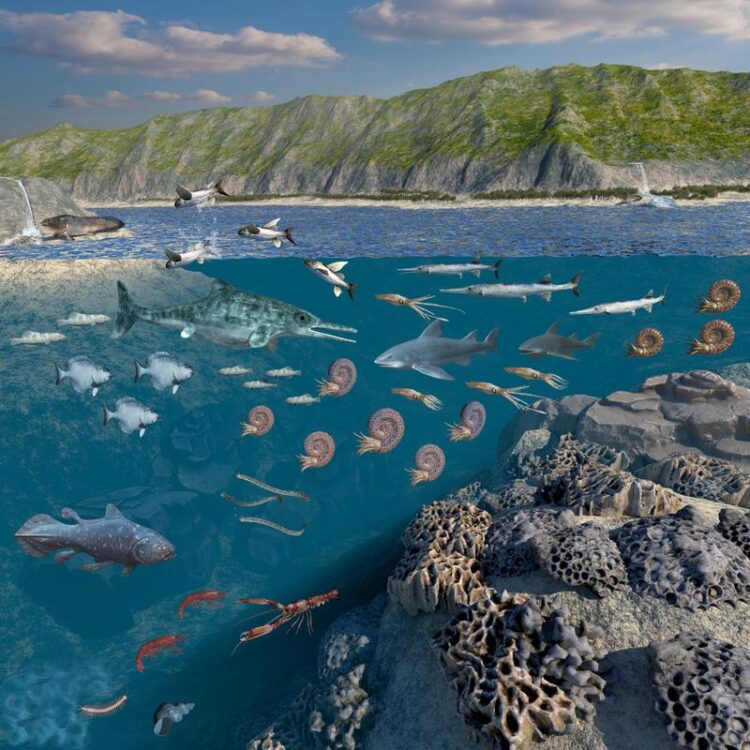Global climate crisis of the Triassic period

Life picture of the Polzberg Palaeobiota
(c) 7reasons / NHM Wien, Alexander Lukeneder
Fossil site in Lower Austria provides deep insights into Austria’s earth history.
Over 6000 unique fossils of the alpine Triassic period have been investigated by NHM Vienna-Palaeontologist Alexander Lukeneder and Palaeontologist Petra Lukeneder from the University of Vienna have investigated. The spectacular remnants are witnesses of one of most severe ecological disasters in the Earth History, the Carnian Crisis. This phase was characterized by a climate change 233 Million years ago, which lead to a gigantic global mass extinction in the oceans of the Mesozoic era. Results have now been published for the first time (Scientific Reports).
The Polzberg locality
A small ravine between Gaming and Lunz am See hides probably one of the most important fossil-sites in Austria. Inconspicuously and almost invisible a true treasure of Earth History is buried. In 233 million year old fine laminated rock layers of the Reingraben Shales true jewels of the Mesozoic era were found over the last 140 years. The black, calcareous to argillaceous marine deposits exhibit a Konservat-Lagerstätte from international reputation. Konservat-Lagerstätte are fossil sites which appear with excellent and entire preservation of the fossil material. 6397 fossil specimens have been housed partially over 100 years in the main collections of the Natural History Museum Vienna, the University of Vienna and the Geological Survey in Vienna. Additional material was collected over the last years by the Citizen Scientists Birgitt and Karl Aschauer (Waidhofen an der Ybbs).
The uniqueness of this locality at the Polzberg in Lower Austria was discussed from time to time during the last century, now the first scientific investigation was published in Scientific Reports.
Inhabitants of a hostile environment
The global Carnian Crisis lasted over 2 million years, traces of the aftermath can be found in the deposits. The contained fossils give insights into the communities in the ancient Reifling Sea for the first time. The late Triassic time was characterized by greenhouse climate with monsoon-like rainfalls. These led to an enhanced input of mud into the ocean. The reefs suffocated and oxygen was running out on the sea floor.
Numerous species could be observed till today, and almost annually new species are detected at Polzberg. Beside ammonites, squids, bivalves, gastropods, crustaceans, isopods and bristle worms fish are frequent. Special features are the shark-like cartilaginous fish Acrodus or the rare coelocanth Coelocanthus. From the coastal swamps even the lungfish Tellerodus was redeposited – a unique fossil worldwide. The vicinity to fresh water is also demonstrated by the frequent branchiopods with Eustheria. Even plants with the conifer Voltzia are represented by small branches.
The dominant element of the entire fauna is the zonal ammonite Austrotrachyceras minor appearing to thousands. The high diversity of the detected fauna and the preservation allow to analyse the environments of the late Triassic and to gain new knowledge on the environmental conditions, food chains and the predator/prey relationships of that time. Starting from small crabs the food chain ranged over small fish up to predatory squids and ammonites, which in turn were hunted by larger predatory fish. Ichthyosaurs are still being searched for, which were probably the largest predators of this ecosystem.
The research is part of two projects financially supported by the Federal Government of Lower Austria (Department of Science and Research) and the Austrian Academy of Sciences (National Committee for Geo/Hydro Sciences) over the next two years.
The publication in “Scientific Reports”:
Lukeneder, A & Lukeneder P. 2021. The Upper Triassic Polzberg palaeobiota from a marine Konservat-Lagerstätte deposited during the Carnian Pluvial Episode in Austria. Nature Research, Scientific Reports. Open Access: https://doi.org/10.1038/s41598-021-96052-w
Further press material and informative links:
https://www.nhm-wien.ac.at/presse/pressemitteilungen2021/polzberg_karnische_kris…
Wissenschaftliche Ansprechpartner:
Priv.-Doz. Mag. Dr. Alexander Lukeneder
Natural History Museum Vienna
Dpt. for Geology & Palaeontology
alexander.lukeneder@nhm-wien.ac.at
Originalpublikation:
Lukeneder, A & Lukeneder P. 2021. The Upper Triassic Polzberg palaeobiota from a marine Konservat-Lagerstätte deposited during the Carnian Pluvial Episode in Austria. Nature Research, Scientific Reports. Open Access: https://doi.org/10.1038/s41598-021-96052-w
Media Contact
All latest news from the category: Earth Sciences
Earth Sciences (also referred to as Geosciences), which deals with basic issues surrounding our planet, plays a vital role in the area of energy and raw materials supply.
Earth Sciences comprises subjects such as geology, geography, geological informatics, paleontology, mineralogy, petrography, crystallography, geophysics, geodesy, glaciology, cartography, photogrammetry, meteorology and seismology, early-warning systems, earthquake research and polar research.
Newest articles

Largest magnetic anisotropy of a molecule measured at BESSY II
At the Berlin synchrotron radiation source BESSY II, the largest magnetic anisotropy of a single molecule ever measured experimentally has been determined. The larger this anisotropy is, the better a…

Breaking boundaries: Researchers isolate quantum coherence in classical light systems
LSU quantum researchers uncover hidden quantum behaviors within classical light, which could make quantum technologies robust. Understanding the boundary between classical and quantum physics has long been a central question…

MRI-first strategy for prostate cancer detection proves to be safe
Active monitoring is a sufficiently safe option when prostate MRI findings are negative. There are several strategies for the early detection of prostate cancer. The first step is often a…



